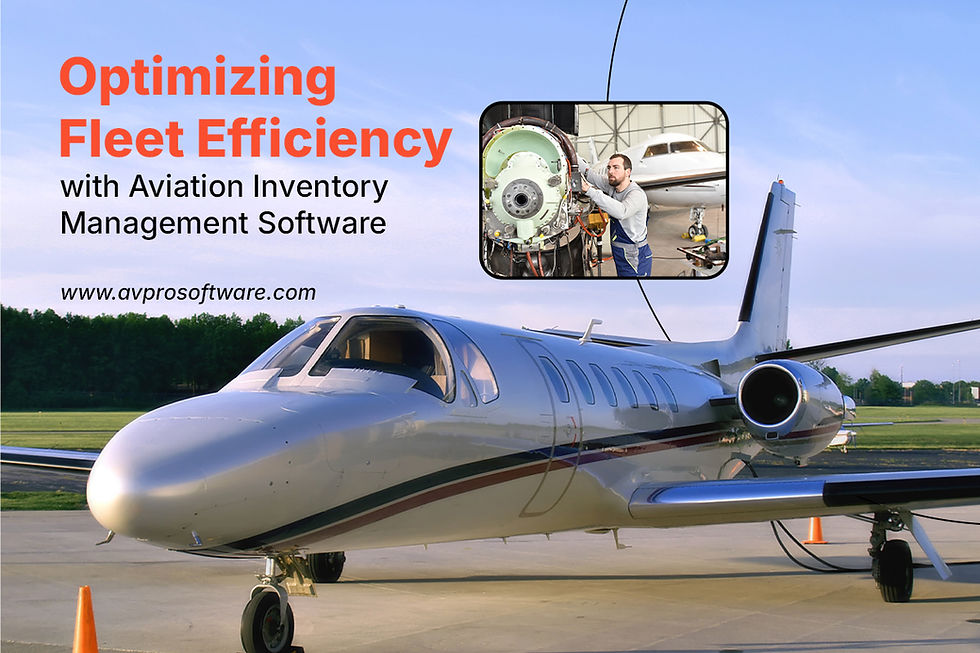Simplify Tracking with Smart Aircraft Parts Inventory Software
- Aaron Schacht

- Jul 7
- 3 min read
Updated: Sep 8
Managing aircraft parts efficiently is a mission-critical task for aviation companies, maintenance providers, and fleet operators. With the complexity of modern aircraft and the stringent regulatory demands, outdated manual methods or generic inventory systems fall short. This is where specialized Aircraft Parts Inventory software proves invaluable.
Aircraft operations rely on thousands of components, each with its own maintenance schedule, life cycle, and compliance documentation. Poor inventory management can lead to unnecessary downtime, increased costs, and even safety risks. By implementing a smart aircraft parts inventory system, aviation businesses can ensure that the right part is available at the right time, every time.
Importance of Aircraft Parts Inventory Management
In aviation, time is money — and safety is everything. Having a missing or incorrect part can delay a flight, disrupt schedules, or compromise safety protocols. Moreover, every part used in an aircraft must meet specific regulatory standards and tracking requirements.
A dedicated aircraft parts inventory system streamlines these processes by offering real-time visibility, traceability, and control. It goes beyond basic stock management to include tracking of serial numbers, batch numbers, expiration dates, repair status, and more.
Core Features of Aircraft Parts Inventory Software
An advanced inventory system designed specifically for aviation environments typically includes the following features:
1. Real-Time Inventory Tracking
Track the exact quantity and location of every part in real-time across multiple facilities. This helps avoid overstocking, understocking, or losing track of high-value items.
2. Barcode and RFID Integration
Modern systems integrate with barcode scanners or RFID technology to make receiving, storing, and issuing parts fast and error-free. This enhances efficiency and accuracy in day-to-day operations.
3. Serial and Batch Number Management
Every part in aviation is traceable. The software logs serial and batch numbers, enabling traceability in case of defects, recalls, or audits.
4. Shelf Life and Expiry Monitoring
Certain parts come with limited shelf lives. Inventory software can track these timelines and alert users when items are close to expiry, ensuring only airworthy components are used.
5. Automated Reordering
To prevent stockouts, the system can automatically generate purchase orders when inventory falls below minimum thresholds. This automation minimizes manual oversight and procurement delays.
6. Maintenance History Integration
Linking inventory with maintenance history allows technicians to see how and where parts were used, replaced, or repaired, improving decision-making and compliance reporting.
Advantages of Using Specialized Aircraft Inventory Software
Transitioning to a digital aircraft parts inventory system delivers several significant benefits:
Improved Operational Efficiency: Automating inventory processes reduces administrative tasks and human error, allowing teams to focus on critical maintenance tasks.
Enhanced Safety and Compliance: Full traceability of parts helps meet aviation regulations, ensuring only approved and certified parts are used.
Reduced Downtime: Accurate inventory tracking means essential parts are always on hand, reducing aircraft ground time and improving flight readiness.
Lower Inventory Costs: Avoid over-purchasing and reduce wastage by maintaining optimal inventory levels based on real-time data.
Better Decision Making: Detailed reports and analytics offer insights into usage patterns, supplier performance, and stock movement trends.
Future Trends in Aircraft Parts Management
With the rise of AI and IoT in aviation, the future of parts inventory management is becoming even more intelligent. Predictive analytics can forecast parts demand based on usage trends, while IoT-enabled sensors can monitor part conditions in real-time. Integration with cloud platforms also supports remote access and collaboration across multiple locations.
Conclusion
Efficient aircraft parts inventory management is no longer optional — it's a vital part of running a safe and profitable aviation operation. With a purpose-built system like the one offered by AvPro Software, organizations can gain full control over their parts inventory, enhance safety standards, and streamline operations from end to end.






Comments